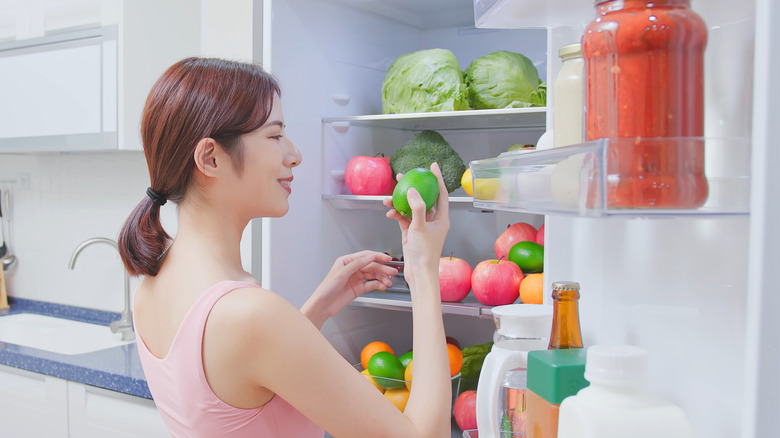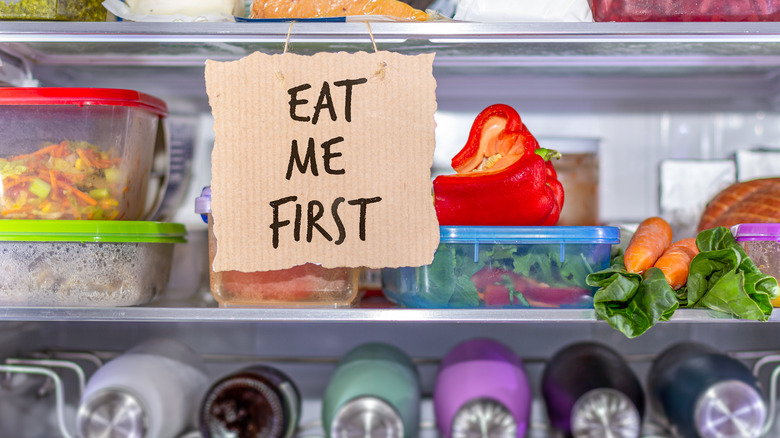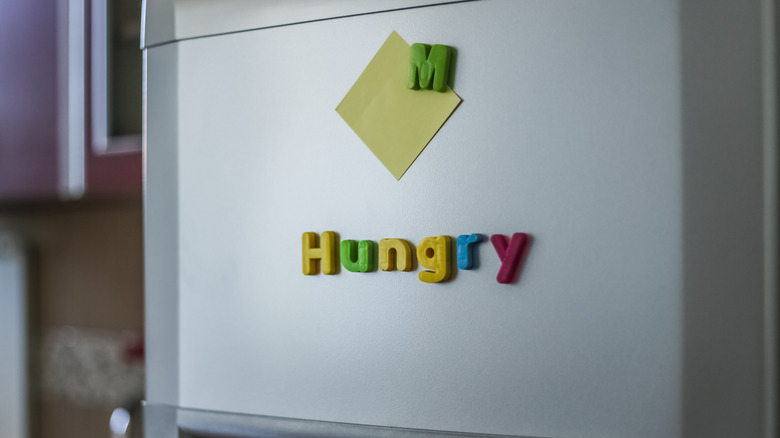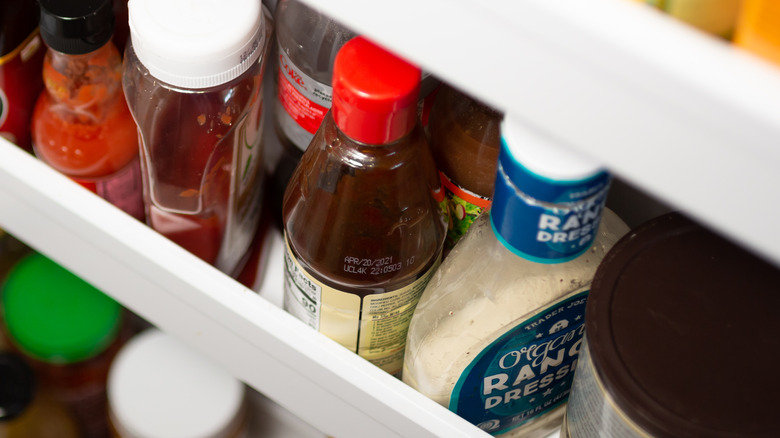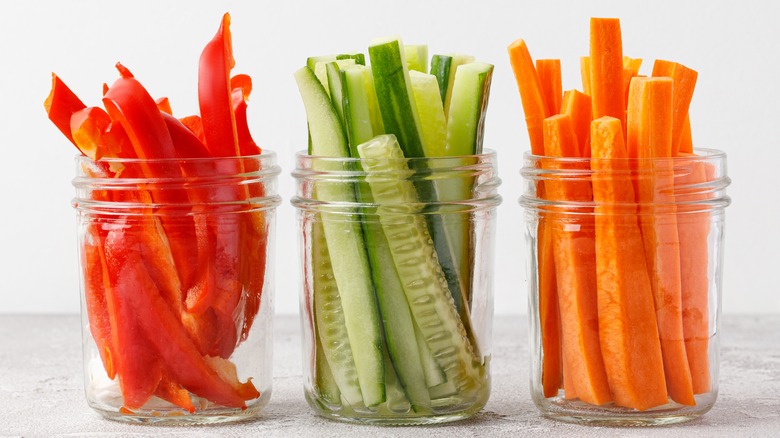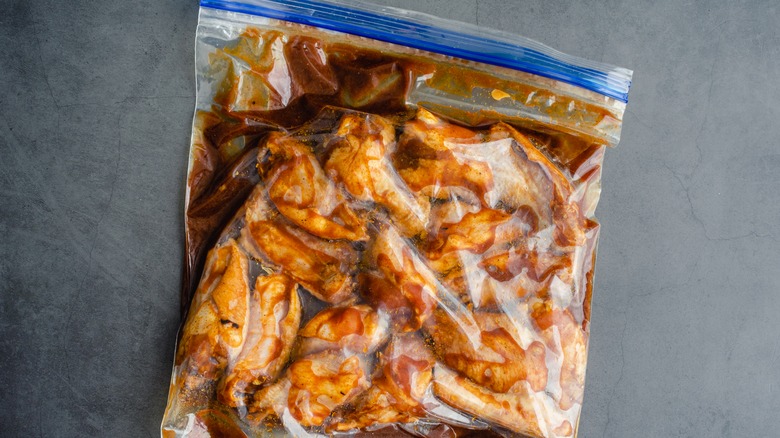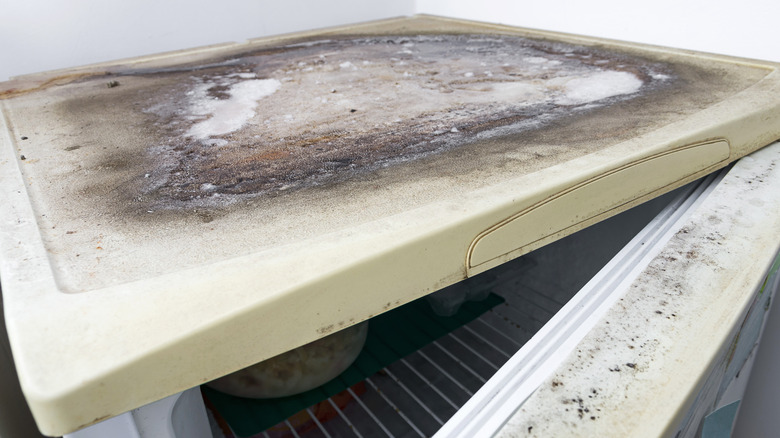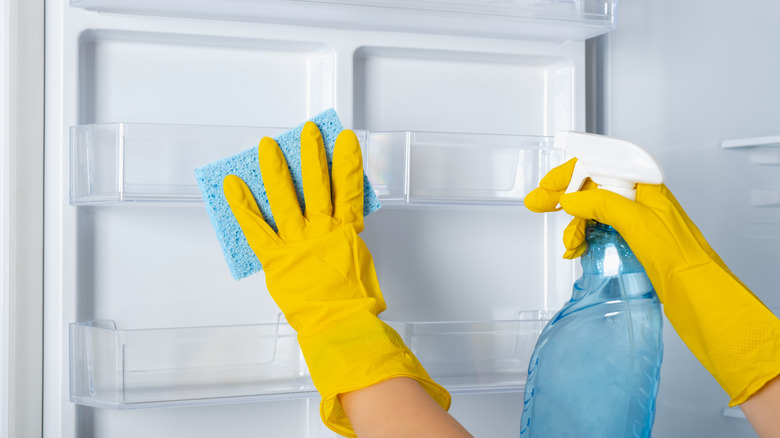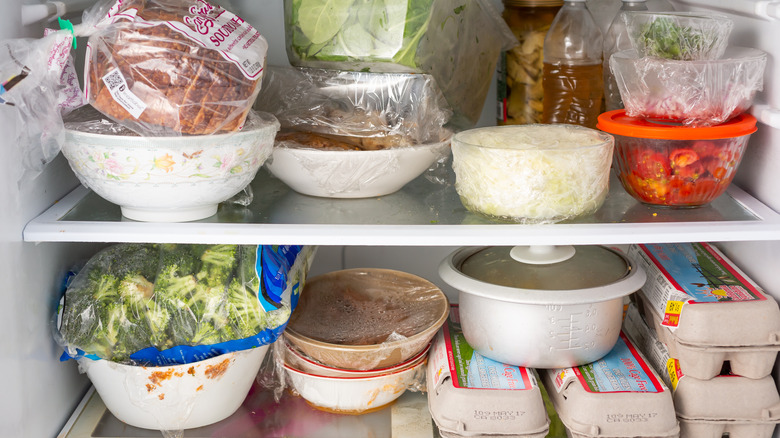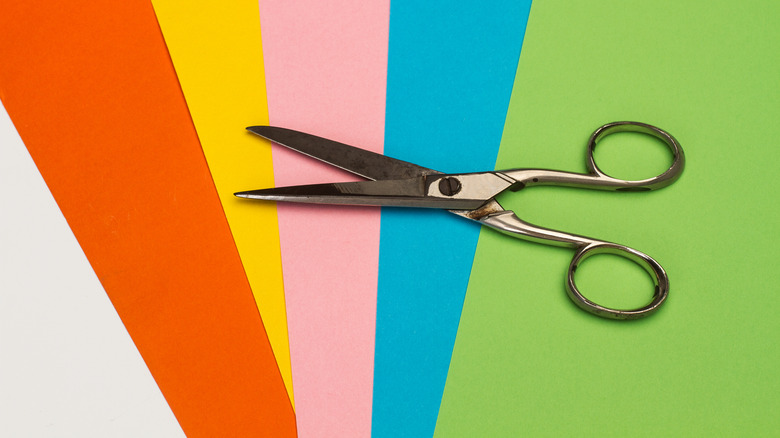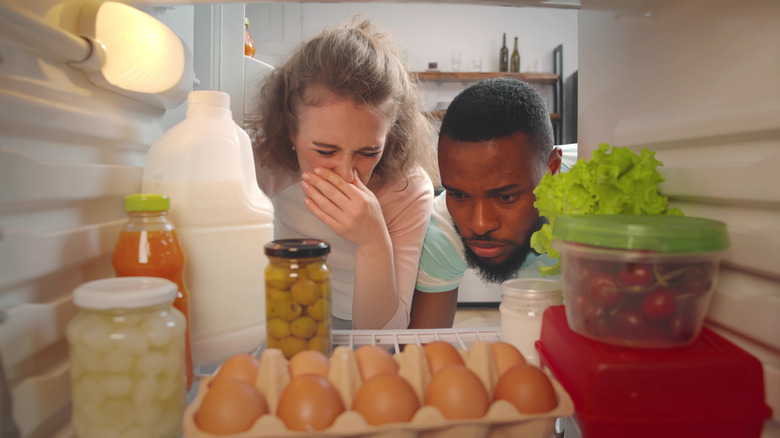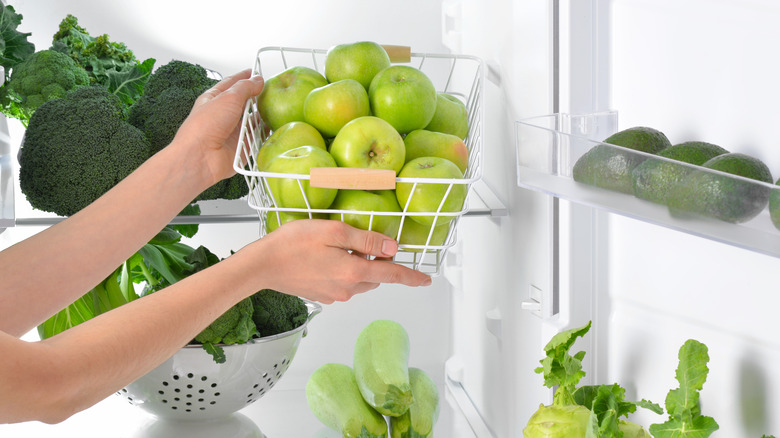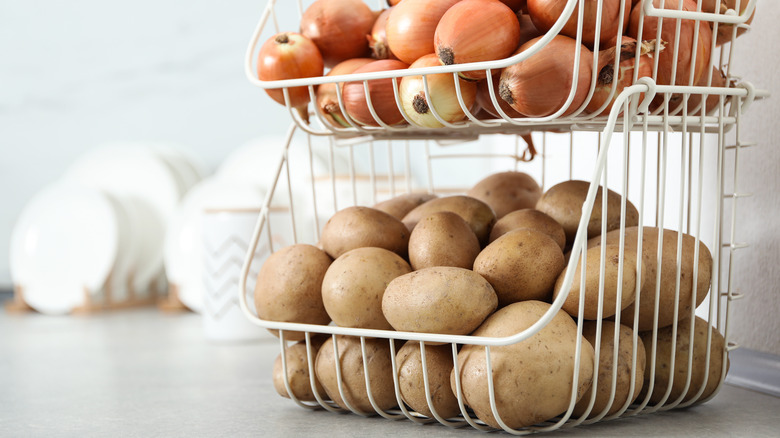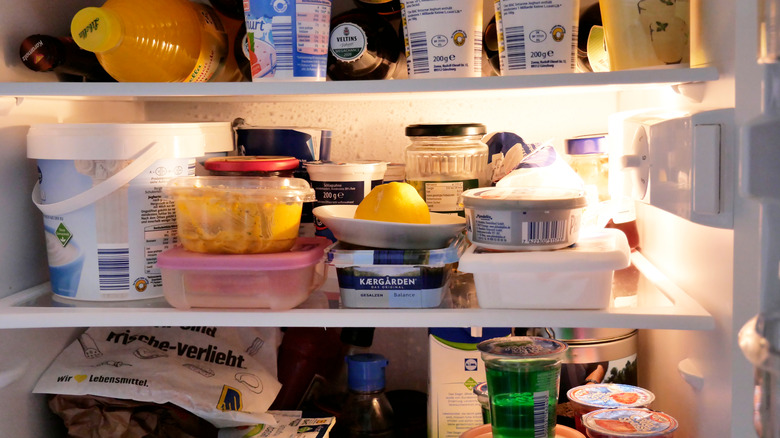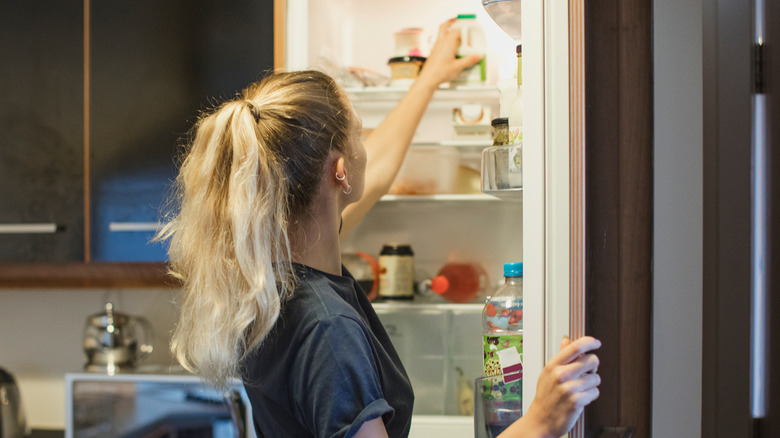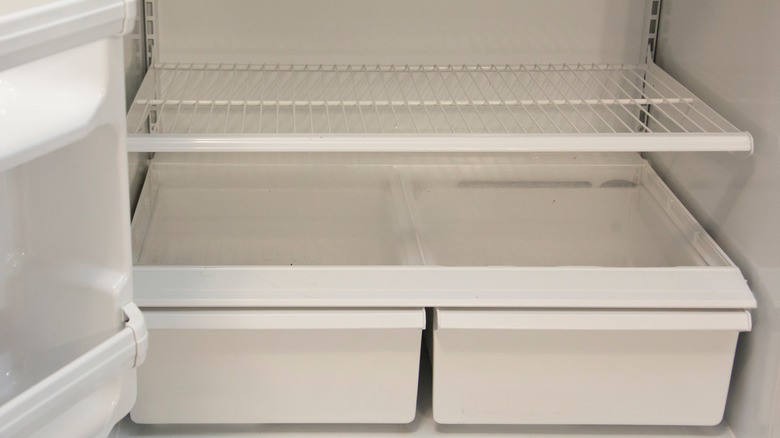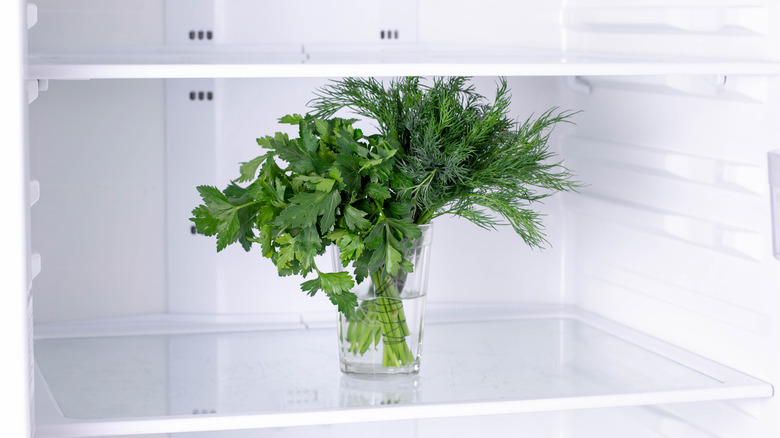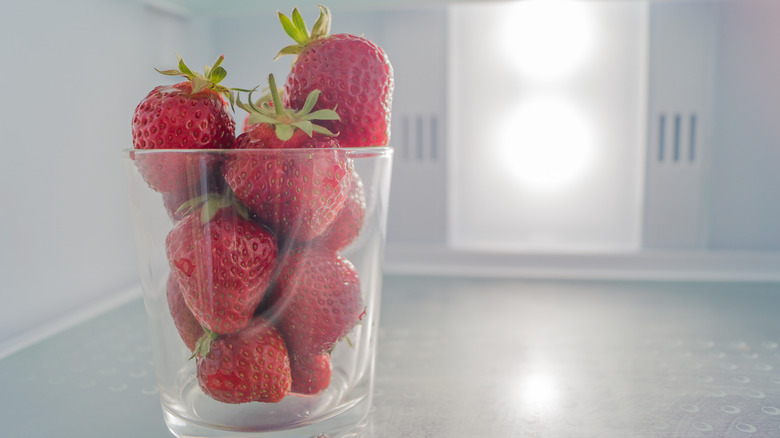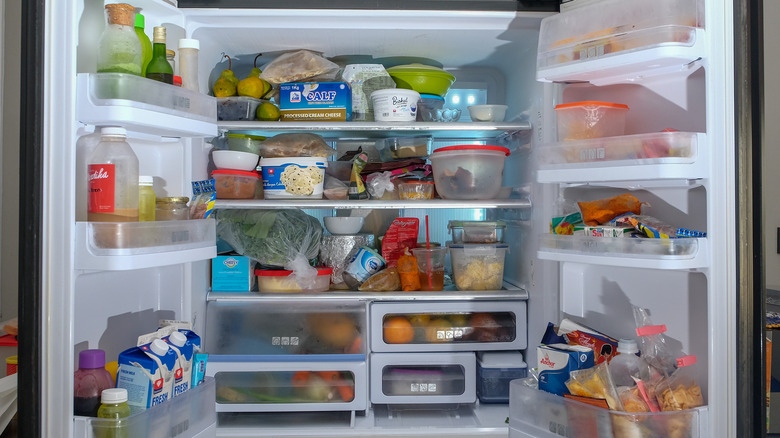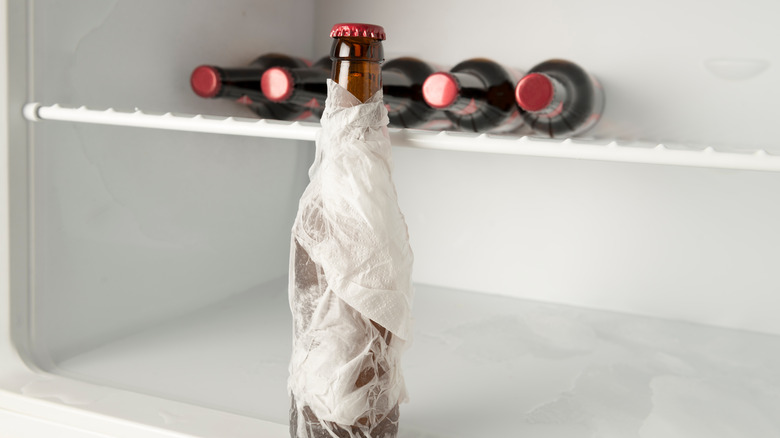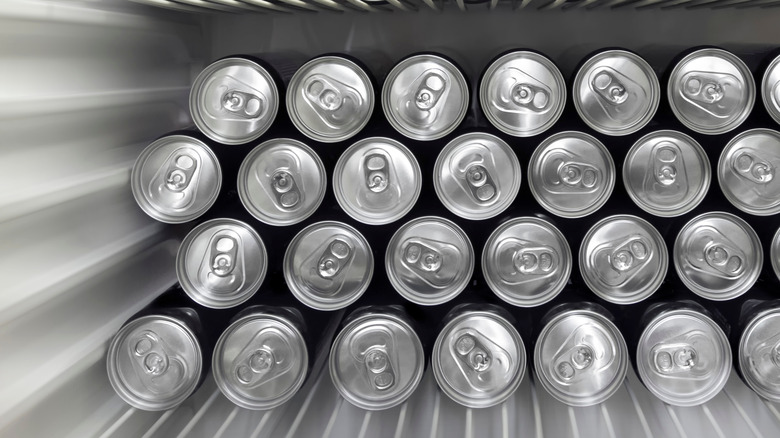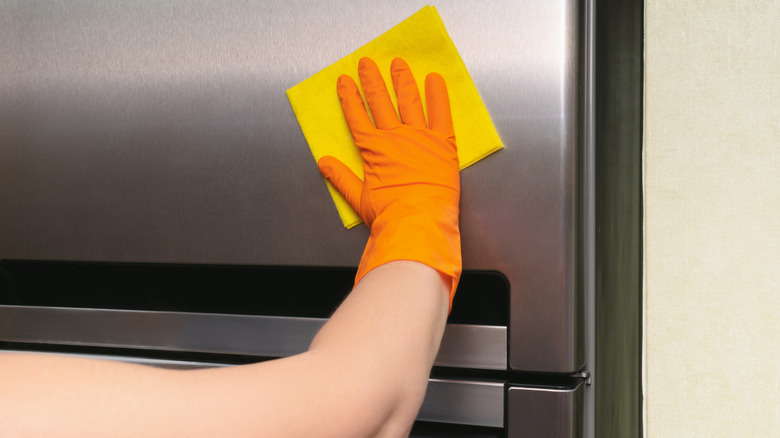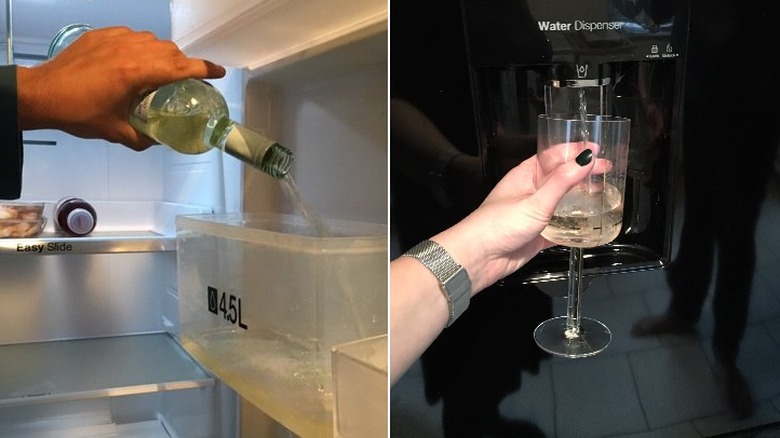24 Refrigerator Hacks You Should Try
Since refrigerators became a domestic must-have over 100 years ago, they've literally changed people's lives. They look stylish and, well, let's face it — having a fridge is way more convenient than trying to keep your food cold in damp cellars or buried under some snow in winter.
Do you take your fridge for granted though? Treating it almost like a cold cupboard, as you simply open the door and shovel in food without even thinking about it? Your fridge works because it keeps food fresher for longer, and that's because it maintains a cool environment and also controls humidity levels. It slows down how fast food spoils and looks after your health as a result (via Science ABC).
Perhaps you'd value some tips on how to use your fridge in a better way. Learn new ways of keeping your fridge clean and handy tips on how to avoid wasting food, as well as how to save space and store food in the right way. Learn about the differences between your fridge shelves, and how you can turn your fridge into a wine dispenser. Is it time you cleared out your fridge, and restocked and stacked up bottles in a different way? Improve your fridge habits so that you're not constantly dealing with the challenge of an over-full fridge or a fridge full of food that's not at its best.
Create a 'need to use' bin
You know how it goes: You reach into your fridge and grab whatever takes your fancy. Whether you're making a sit-down dinner, lunch on the go, or even a light bite, you're going to use the foods that appeal first. That means that you're not necessarily using up foods that need to be eaten, some of which may be languishing at the back of your fridge or covered by fresher produce in your refrigerator crisper. The result? Food that goes off before you can eat it and therefore gets wasted. Fortunately, an ingenious hack posted on Instagram by @nutrition.for.littles offers a nifty solution.
Gather all the items in your fridge that are nearing their use-by dates and anything that needs to be eaten or thrown in the next few days. Put all of these into a plastic container that fits on your shelf. You can also label it by writing "Need to use" on the front. It acts as an effective reminder to look in this bin first before using the fresher stuff. If you want a snack, for example, or to add a side dish to a meal, then you may be able to use up some ingredients from here. Perhaps the mix of your use-up foods will inspire a recipe, too!
Use your fridge as a whiteboard
You've probably written funny notes on a refrigerator using magnetic letters. You may have developed this into leaving handy Post-It notes on your fridge or even attaching a piece of notepaper using a magnet. Of course, you can also attach a board to write on. Leaving reminders of appointments, shopping lists, and To-Do chores on your fridge door makes sense. After all, this appliance is the heart of any kitchen, and you'll no doubt face and open your fridge several times a day. One Reddit tip offers another idea on what to write on your fridge and how.
The hack involves writing directly onto your fridge using a whiteboard marker. This means that you'll be able to wipe it off easily. Make a list of meals that you can make with the ingredients and produce you have stocked up on. Sometimes, it can be difficult to see what you have inside the chiller and make your meals accordingly. The result is wastage — and to avoid this, you could write down what meals, snacks and beverages you can make. Another method is to write down which items you've stocked up your refrigerator with and cross off each item as it's used. When you restock and are working out your menu for the week, you can start again.
Store condiment bottles in an egg carton
Most people store their condiments in the fridge door. After all, this seems to be the ideal place in terms of position, temperature, and storage space. In other words, condiments fit pretty easily here.
However, this shelf can sometimes become pretty cluttered. Thankfully, there are people who take the time to think about smarter solutions to such fridge frustrations. One of them is celebrity chef Alton Brown, whose condiment conundrum demonstration is highlighted with his mustard caddy creation featured in Yahoo! News.
Take an egg carton and cut off the lid, so you're just left with the lower half with pouches for the eggs to nestle in. Put this inside the shelf on your fridge door and turn your condiments upside down before slotting them, lid first, into the carton. They should sit snugly and not overcrowd each other. This hack also ensures that the contents of the condiment bottles empty into the neck. Thus, they're way easier to get out of the bottle, with no sauces going to waste because they're obstinately stuck at the bottom. (Your only challenge might be to come up with some interesting egg hacks so that you have an empty carton to use.)
Grab and go with self-serve food in containers
Any hack that gets kids eating healthier (and makes it easier for grown-ups to monitor that) is a no-brainer. However, when youngsters pop their heads into the fridge, they're confronted with a chiller full of various produce and ingredients, which could have them grabbing the easiest, but not necessarily healthiest, choice. Or, they may retreat to other non-refrigerated items such as processed snacks and candy. The advice of self-serve, grab-and-go food offered on Instagram by @theeagerteacher definitely has the ingenuity of a classic hack. While aimed at kids, this is also a fantastic idea for adults wanting to kerb unhealthy fridge raiding habits.
Wash and prep carrots, cucumber, or grapes so that they can be grabbed and eaten straight away. You can take the stalks off grapes, as well as create slices of cucumber which are peeled with stripes (which you can achieve if you follow a cucumber hack). Put these into jars and place in the shelves on the fridge door. This way, as soon as anyone opens the fridge, they can immediately see what's ready to eat and grab a handful. Youngsters don't have to ask any adults, either, so it takes the pressure off parents. Meanwhile, grown-ups can graze guilt-free. The jars are also handy for adding to packed lunches, and to add to a meal as a side. Keep fruit and veggies fresher for longer by putting lids or covering the containers.
Vacuum pack food to save space in the fridge
Glossy magazines revealing the contents of celebrity fridges often show neatly stacked shelves. However, in reality, it can sometimes be trickier to stock up so that everything fits in and isn't just crammed in. There are ways in which you can maximize the space in your fridge — and these are not always about what produce and products to put where and in what order. A tip demonstrated on TikTok by @staceydixon shows how to make produce more compact so you can get more in.
Put whatever you want to store in the fridge into a sealable bag. Seal it most of the way, leaving a gap at the top. Next, immerse the bag into a bowl of cold water so that it covers what's inside but doesn't fully submerge it. As you do this and gently press, you'll notice that the air is expelled. As the air escapes and the water adds pressure, the bag will seem to "stick" to what's inside, as it's become vacuum sealed. Seal the bag the rest of the way. To make your tightly packed bag flatter, thinner, and more evenly shaped, place it between a tea towel and roll it by rubbing the top layer of the towel with your palms. It's now ready to put in your fridge and will take up less room than a looser bag.
Keep fridge tops clean with wax paper
If you're not tall enough to look on top of your free-standing fridge, then there's a chance that apart from a quick wipe, you may forget about it altogether. However, a fridge that's in the kitchen is prone to collecting dirt and grease, which can easily settle. If you're not getting up there and thoroughly cleaning (which is not easy to do, as it's not so easily reached), then it'll soon start to become a bit grimy. Interestingly, adding wax paper to the top of your fridge is a great solution.
Cut some of the paper to size so that it fits your fridge and lay this down, Instead of any dust or other greasy particles being attracted to your fridge's surface they'll stick to the wax paper instead. You won't have to get up top and scrub away either. Instead, just check your paper — and once it's looking a bit grubby, simply remove and toss it before replacing with another sticky, debris-attracting layer. Thankfully, you won't have to do this too often, and your wax paper sheets may not need to be changed for weeks or even months.
Clean your fridge with vinegar and vanilla
With all types of vegetables and fruits, as well as raw food and cooked dishes, packed into a small space, spills, leakages, and splashes are inevitable. Just as you'll want to give the exterior of your refrigerator a wipe down, the inside surfaces also need to be cleaned so that food doesn't get stuck onto shelves and any greasy marks are removed. How do you clean your fridge?
While you may take as much out as possible for a deep clean from time to time, you can also create your own fridge cleaner with a top cleaning tip from cleaning professional Chantel Mila (via Metro). In a spray bottle, mix a cup of lukewarm water with a few drops of vanilla extract and ½ cup of white vinegar. Add the top and spray inside your fridge before wiping down. You can keep your homemade fridge cleaner for around three months. As well as giving your shelves a clean, deodorized smell, the spray is really good at removing stubborn, stuck-on food and spillages. It's effective enough to be used for a deep clean without dismantling your fridge and taking out all the different removable components.
Of course, if vanilla isn't your favorite scent and you prefer a fragrance that's a little fresher, then you could add in lemon essential oil instead (via One Good Thing).
Stack bowls to save space
Everyone loves hacks so much because they're often practical and simple, meaning you don't need any special equipment or knowledge to try them out. Whether you have a busy family life and cook up a lot of dishes that need to be refrigerated or are cooking for a special occasion, it can be a challenge to balance lots of bowls in your fridge. You may find that you don't have the space, or can only cram them in if the bowls are sitting on each other. Sometimes, they may only fit in at an angle, too.
If you can relate (or are wondering how you're going to rejig your fridge to hold bowls of prep ingredients for a dinner), then you might want to follow a great TikTok tip by @livecomposed. This hack offers a temporary fridge storage hack. On top of a bowl that's been placed in your fridge, add a wire rack. You can then easily stack another bowl on top without it touching the one below. This means that whatever's inside is less likely to spill over, either.
A similar, simple idea posted on Reddit is to use chopsticks between the bowls. Freeing up space in your fridge, the sticks are placed across the lower bowl, with a gap between them. Another bowl is then placed on top, resting on the chopsticks. You might prefer this method if you're cooking up some Asian noodles and need chopsticks to eat them with!
Make shelf liners from place mats
While you can purchase fridge liners, you can also make your own at a fraction of the cost. Lining the crisper at the bottom of your fridge and your shelves really saves time and energy when it comes to cleaning, too. Any spills or drips will fall onto the liners instead of directly onto your fridge. You can remove the liners, wipe clean, and then put them back in place. All you need for this hack, which is featured on One Good Thing, is a pair of scissors, a marker, and some plastic placemats.
Take the drawer out of your fridge and place it on the reverse side of a cheap placemat. Draw around it, so that you can cut the mat to size. It should fit inside and line the bottom of the crisper. If you can't remove the shelves on the door of the refrigerator, then use a piece of paper to mark the dimensions, as this is more pliable to bend into shape. Use this as a template, cutting around it. These liners are called fridge coasters by surburble, and add an attractive design to your fridge. As well as color coding or using a placemat style that matches your kitchen, you can also use clear ones if you want the light to penetrate glass shelves.
Get rid of nasty odors with bicarbonate of soda
Whether some food's gone off or you've left some stinky food uncovered, you probably know what it's like when you open the fridge door and are greeted with an unpleasant odor. While you may be able to throw away the offending item, or get a lid or bag up something that's a bit ripe, it's not always so simple to get rid of that lingering whiff. Thankfully, there's a fridge cleaning hack that's helpfully highlighted in Good Housekeeping that guides you on how to simply eliminate nasty odors. It requires no scrubbing, and all you need is one simple ingredient: bicarbonate of soda.
Make your anti-odor cleaning solution with a liter or warm water, mixing in a tablespoon of bicarbonate of soda. Use this to wipe all the surfaces inside your fridge, and make sure this includes not just shelves and drawers, but also the walls inside and also the door seal. You can guard against smells that threaten to permeate the fridge by leaving some bicarbonate of soda inside the fridge, too. Put it into some type of container with the lid off, and leave it for no more than three months. Just as many foods have a use by date added, you could add this to the container so it doesn't sit there past this date.
Separate ethylene producing and sensitive produce
Have you ever noticed that sometimes, foods seem to go off faster than they should have, even when they're in the fridge? It could be that they're being gassed in there, according to an article published by Penn State University. Pretty much all fruits produce a gas called ethylene as they ripen, and some vegetables do, too. While this is natural, it can cause other produce that's within the confines of your fridge to deteriorate. Some produce is more sensitive to this gas than others, and to stop one ethylene-producing food from spoiling another, it's best to keep them separated in the fridge.
Fruits that love producing a lot of the gas in particular include peaches, nectarines, and cantaloupes, as well as avocados. Meanwhile, the gas makes carrots and parsnips bitter, yellows kale and broccoli, and makes cucumbers turn mushy. Lettuce goes limp, as does cabbage and spinach. Meanwhile, zucchini and summer squashes go off quickly when exposed to the gas, and asparagus loves its tenderness and becomes tough. According to university professor Peter Ferretti, the best way to store the high gas producers is by bagging them. Ethylene-sensitive foods can be put in paper bags that are closed at the top.
Keep certain produce out of the fridge
Keeping your fridge clean means making sure that any food that's gone off is thrown out. Another great way to free up space is to take out some of the produce that doesn't need to be refrigerated in the first place.
Admittedly, when you've done a good shop for groceries, it's tempting to fling most fruit and vegetables into your crisper drawer. However, you'd benefit from being more discerning. In fact, some foods last longer or fare better if you don't keep them refrigerated. Of course, there are also goods that you'd be advised to store in your fridge (via Farmers' Almanac).
Tomatoes are more likely to turn mushy in the fridge, while the fridge is too cool for potatoes. Citrus fruits and berries are best left out. If you want to try out some fun bell pepper hacks, then keep them wrapped in a paper bag to stay crisper. Meanwhile, whole melons and bananas are best unrefrigerated. Unripe peaches and plums, along with other stone fruits, need to ripen at room temperature. Bread dries out in the chiller, while garlic can soften, and uncut onions are best stored in a paper bag out of the fridge. You can put most vegetables in the fridge, though you may care to separate certain fruits and vegetables. You can keep similar types together, so if you fancy trying out some beetroot hacks, you can keep your beets with your turnips and radishes (via Martha Stewart).
Get rid of the packaging
Packaging takes up space, and also makes it difficult to get to items if, for example, they're at the back of a box. Added to this, you don't always know when things are running out, either. Free up space and reorganize your fridge by getting rid of bulky packaging and storing items in an open basket or bin. You can see what you have and easily reach it, and it should slot into one of your fridge shelves easily, too. Put certain products and produce together in one container, such as snacks. Meanwhile, make sure the use-by date is not thrown out with the packaging (via Organise My House).
Start with making some room in your fruit and vegetable drawer, which can soon get full. Per Good Housekeeping, you can consider storing unpackaged produce in food bags. If you want to save even more space, then a clever trick is to use binder clips. Hang your food bags in the fridge from shelves (if you have wire ones, that is), so that you're using up every available space, including under the shelf. Not only can you fit more in, but some simple reorganization also enables you to streamline how the contents of your fridge are arranged. Plus, it means you only recycle packaging after a shop, and not each time you have to open a new packet.
Keep milk in the coolest part of the fridge
Where do you keep your milk? If your answer is on the shelf attached to the fridge door, then you may find that your milk is not lasting as long as it could do.
While this shelf looks like it's the perfect fit for cartons, there's a simple way in which you can keep milk fresher for longer. In an Eat This, Not That! feature, USDA food safety expert Meredith Carothers offers up some advice on how the different temperatures within your fridge matter. While you may not be measuring the temperature inside your fridge, you should be aware that milk needs to be kept at below 39.2 degrees Fahrenheit, so as not to spoil. It makes sense, then, that the shelves on the door are more likely to be warmer than the rest of the fridge, especially if you're in and out, opening and closing the door fairly frequently.
Keep your milk cartons in the colder areas of your fridge. These include the lower shelves; the lower down, the colder it is. The back of a refrigerator is also colder than the front, yet if you store milk at the back and the bottom, it may start to freeze. Don't worry if your milk does become frozen, however, as there's no issue with freezing it — it's still safe to consume. When freezing, remove a cupful of milk first, because the frozen liquid will expand.
Use your fridge shelves correctly
Organizing your fridge isn't just about space-saving; it also has a knock-on effect on food safety, too. Hacks are not only handy, but they're also pretty useful at inspiring good habits for a reason.
For example, where in your fridge do you store your uncooked meats, including fish? Keep them on the bottom shelf. Not only is this part of the fridge cooler than up top, but you're also minimizing the risk of raw meat juices contaminating other produce in your fridge. You don't want to be grabbing a piece of cheese, only to find a raw chicken is above and potentially dripping down (via Hello Magazine).
Create a fridge storage system by keeping fruit and vegetables wrapped up and stored in the bottom drawer (or the crisper), as this keeps moisture in. Keep your cooked foods and produce that's ready to eat, such as cheese, on the middle and top shelf of your fridge. If you've got leftovers, get them refrigerated within a couple of hours, and eat them within a couple of days (via Tap Warehouse).
Get rid of water under your vegetable crisper
The author of Gaff Goddess and also Decor Galore, Laura de Barra, is a mine of helpful home hacks. One which she features on her TikTok channel is focused on the fridge. More specifically, this is for anyone who's had an issue with water collecting under your fridge drawer.
If your crisper floats in your fridge — picture your fruit and veggies bobbing up and down as if they're on the high seas — then the chances are your fridge's drain is blocked. Take a look at the back of your fridge, close to the bottom. On most appliances, you'll see a hole and two draining channels or what the tipster calls the fridge's "collarbones." Food (and ice, if your fridge setting is too cold) can block the drain. As water trickles down the back wall, it won't drain out immediately, and instead drips down under your bottom drawer. Use a straw cleaner to unblock the fridge. There's also a special tool that's specifically designed for this purpose, which is green with a loop at the end. Whatever you use, wipe down the channels and around the area with water and white vinegar to sanitize it.
Keep herbs fresh when refrigerated
If you love cooking, then you probably love having fresh herbs on hand. You may even grow your own along with other windowsill greens. According to a Food & Wine article, how you keep your herbs in the fridge depends on whether they're tender or hardy varieties.
If the stems are green and soft (such as parsley, cilantro, and basil), then they're the former. If the stalks are woody (such as rosemary and sage), then they're the latter. Store softer herbs in a glass with some water in the bottom, in the same way you would a bouquet. You can do the same with a jar, too, even closing the lid. You'll need to change the water every two days. Meanwhile, wrap hardier herbs in a moistened kitchen towel and put some saran wrap around before putting them in the fridge.
You can also use a glass of water to revive vegetables, as demonstrated on TikTok by @alesharuddenklau. If your broccoli is looking brown and a bit limp, then cut off the end of the stalk and pop it in water so that it covers part of the stem. Leave it in the fridge, and it'll soon look green, crisper, and refreshed! Meanwhile, don't forget you can also freeze tough herbs. You could try storing softer herbs in oil with a clever ice cube hack.
Soak fruit in vinegar for a longer fridge life
Chef Mum Marie's Facebook tip on how to make fruits like strawberries last for weeks was featured in a Mail Online article. The tip came in response to an online suggestion that fruit stays fresher if stored in the fridge in mason jars. To follow the hack, you need to soak your fruit in a vinegar solution, so that the acidity can act like a preservative, before storing in the fridge.
There are a few steps to follow, but the result is fruit that lasts a lot longer. Mix one part vinegar to four parts water, with enough liquid to cover the fruit. After the fruit has been soaking for half an hour, scoop it out and rinse in cold water. You want to eliminate any vinegary taste, so make sure you do this thoroughly. Next, you want to dry your fruit. The best way to do this is to leave it on a kitchen towel so that the moisture is drawn out. You want whatever fruit you're using to totally dry before you add it to a jar. You can also add some kitchen towels into the jar to absorb any additional moisture. If you prefer, you can use lemon instead of vinegar. While this hack is a winner with strawberries, it doesn't work with raspberries, although they can be dried out with a kitchen towel after being rinsed.
Make shelves more user-friendly with a Lazy Susan
If your refrigerator is packed (perhaps for good reason), then you'll no doubt relate to the frustration of trying to reach some jar that seems to be lurking right at the back. Reaching in to retrieve anything from the back of a fridge shelf is not without challenge. Even if you're successful in weaving your fingers deftly through the other jars and produce, you still have to bring your catch through this maze to retrieve it. Bottles are often knocked over, with ingredients spilling, in the attempt. There's also the possible frustration of not quite knowing what's hidden behind other fridge contents, with no practical way of browsing. The good news is that there's a simple solution (via House Beautiful).
You need to mobilize your fridge items, and the best way to do that is by putting a Lazy Susan on your fridge shelf. Stack the turntable up with jars and whatever else that's cluttering up your shelves. You can now spin them to see what you've got on your shelf with ease. As well as looking tidy, the other advantage is that you won't forget about something at the rear, letting it languish way past its use-by date. You could even add more than one Lazy Susan if you have room, perhaps categorizing your contents in some way.
Use a wet paper towel to cool down bottles quickly
Whether it's hot outside or you've heated up from working out in the gym or doing some gardening, there's nothing quite like a cool drink to quench your thirst. After a long day, or if a social occasion suddenly happens, you may want to grab a cold beer or some wine. What do you do, though, if you forgot to put your desired bottle in the fridge? Drinking it warm isn't an option, so you may throw in a few ice cubes, but this can dilute your drink. You might decide to quickly get it in the chiller and wait, but this defeats the object of a cold beverage right away. Or, you could follow an excellent instant cooling hack presented by Swirled if a freezer is part of your refrigerator.
Wet a kitchen towel, but don't drench it. Wrap it around your warm bottle. Pop the draped beverage into the freezer and wait around a quarter of an hour. Now, you may have put a bottle in the freezer before to get it cooling down quicker than it would in the fridge. Because the towel is not heavy and has a fairly small mass compared to its surface area, it cools down far quicker than the air around the bottle. Don't forget about your frozen treat, though, or you may find it's exploded in the freezer instead!
Align soda cans using the packaging
Sometimes, the simplest of tasks can cause problems. It's hardly rocket science putting soda cans or beer cans into a fridge, but they often roll around or fall over, depending on whether you're trying to stand them up or lay them down. You could try putting them in your bottom drawer, but you could end up breaking it, and if you're keeping a well-stocked fridge, then it's no doubt full of fresh fruit and vegetables. Where there's room for a hack, there's a TikTok post to suggest one — and @joshfisherky has a simple yet effective way to load cans into the refrigerator.
Open one end of the cardboard can carrier. With this opened end facing the fridge, slide the box onto the shelf. Open the other end, and with your hand on the cans, pull the box so that it slides off. Your cans will be left as they were when they were packaged up, in neat rows that perfect fit together and are totally aligned. As well as looking neat, it's a pretty darn quick way to load a fridge full of cans. It works great for a party when you want to fit as many cans in as you can and not end up with them all mixed up together.
Use a binder clip to stack bottles
There's something so refreshing about opening up your fridge, especially on a hot, summery day, and beholding a stack of ice-cold bottles of your favorite elixir. Whether you want a cold beer or a soda, it's not always easy to create a pyramid stack of bottles that don't roll about on you refrigerator shelf. You know how it goes: You lay down one row of bottles, but when you add another layer, they start to shift underneath. A Today hack offers a practical solution, and all you need is a binder clip.
This tip only works with wire shelves and not solid ones. Lay down your first row of bottles on your shelf, so that the caps are facing you. Next, open your binder clip and push it up from below the bottle shelf so that it clips around the two tray wires next to your end bottle. The bite of the clip pushes up to rest against your bottle to stop any bottom row bottles rolling. If you put down four bottles, you can now stack three on top, then a row of two, with a single bottle on the top of your pyramid. You can also do this with cans; keeping the base row small means you're taking up less room. Not only does a well-stacked fridge shelf look great, it also means you can fit in plenty of other ingredients in there for things like a summer cookout.
Remove scratches from stainless steel fridges
With all the wear and tear of cooking in your kitchen, as well as being in and out of your refrigerator for ingredients and tasty snacks, your fridge is bound to get a bit scuffed. While you can wipe down spillages inside and dirty marks outside, what do you do if your stainless steel fridge gets scratched? Because the surface is sleek and shiny, those engraved markings are really going to show up. If you're houseproud, then you may feel that your less-than-pristine fridge exterior makes your whole kitchen look a bit shabbier. Reduce the visibility of scratches by following a simple hack featured on TikTok by @lizamaya_style using toothpaste and olive oil.
Using a toothbrush, scrub the affected area with a whitening toothpaste. You want to follow the grain of the fridge's surface when doing this. Then, wipe the surface with a damp microfiber cloth. Grab a dry cloth and put some oil on this before rubbing where the scratch is. You'll immediately see that it's definitely less noticeable, and if it's a light scratch, then it may have faded to being almost unnoticeable. Mr. Appliance advises checking if your fridge is actually stainless steel first. It shouldn't be magnetic, for starters. Another tip is to clean the surface with white vinegar and rinse with water first, too. Deal with deeper scratches using sandpaper in place of toothpaste, using a finer grit to buff following a coarser one.
Use the water dispenser for wine
Many modern fridges also serve up cold water, and this can be so useful if it's hot out, or just for grabbing a glass of H2O to drink with dinner. However, a party-centric hack posted on Twitter by @iliketweet suggest a fun alternative that turns water into wine. Not only can you save space with this terrific tip, you can also have wine on tap (quite literally).
Instead of filling your water dispenser container with water, fill it with wine instead. That way, your wine will keep chilled and be dispensed at the front of the fridge. This is a perfect solution for social drinks, especially if you don't want guests to be in an out of the fridge, which could stop food in there from cooling down properly. It also minimizes the risk of bottles in the fridge rolling around or falling over. You'll also have more room for your party food, too. Don't forget to clean the dispenser system, though, or it could clog up your fridge's tubes.
